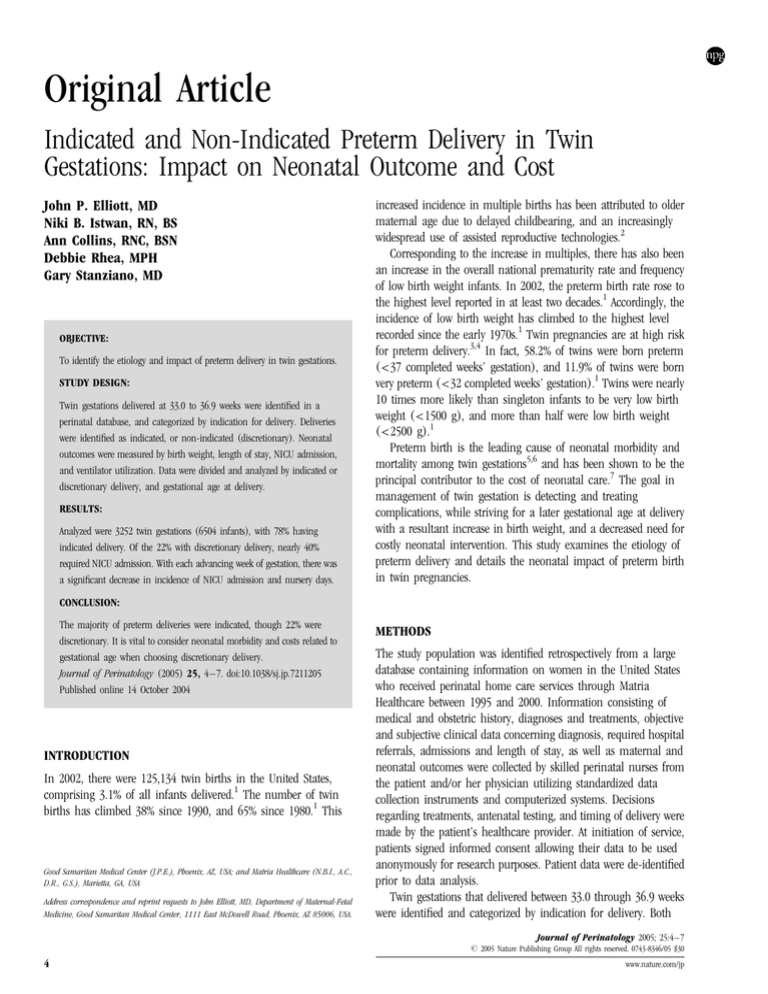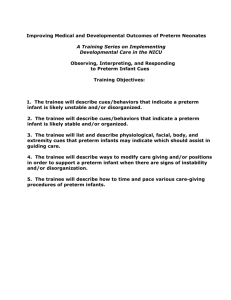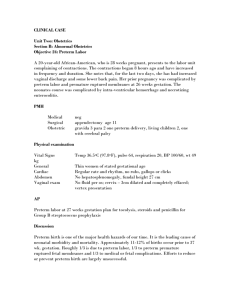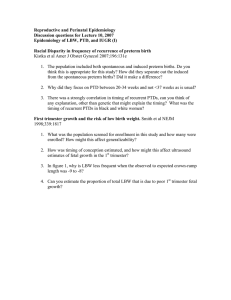
Original Article
Indicated and Non-Indicated Preterm Delivery in Twin
Gestations: Impact on Neonatal Outcome and Cost
John P. Elliott, MD
Niki B. Istwan, RN, BS
Ann Collins, RNC, BSN
Debbie Rhea, MPH
Gary Stanziano, MD
OBJECTIVE:
To identify the etiology and impact of preterm delivery in twin gestations.
STUDY DESIGN:
Twin gestations delivered at 33.0 to 36.9 weeks were identified in a
perinatal database, and categorized by indication for delivery. Deliveries
were identified as indicated, or non-indicated (discretionary). Neonatal
outcomes were measured by birth weight, length of stay, NICU admission,
and ventilator utilization. Data were divided and analyzed by indicated or
discretionary delivery, and gestational age at delivery.
RESULTS:
Analyzed were 3252 twin gestations (6504 infants), with 78% having
indicated delivery. Of the 22% with discretionary delivery, nearly 40%
required NICU admission. With each advancing week of gestation, there was
a significant decrease in incidence of NICU admission and nursery days.
increased incidence in multiple births has been attributed to older
maternal age due to delayed childbearing, and an increasingly
widespread use of assisted reproductive technologies.2
Corresponding to the increase in multiples, there has also been
an increase in the overall national prematurity rate and frequency
of low birth weight infants. In 2002, the preterm birth rate rose to
the highest level reported in at least two decades.1 Accordingly, the
incidence of low birth weight has climbed to the highest level
recorded since the early 1970s.1 Twin pregnancies are at high risk
for preterm delivery.3,4 In fact, 58.2% of twins were born preterm
(<37 completed weeks’ gestation), and 11.9% of twins were born
very preterm (<32 completed weeks’ gestation).1 Twins were nearly
10 times more likely than singleton infants to be very low birth
weight (<1500 g), and more than half were low birth weight
(<2500 g).1
Preterm birth is the leading cause of neonatal morbidity and
mortality among twin gestations5,6 and has been shown to be the
principal contributor to the cost of neonatal care.7 The goal in
management of twin gestation is detecting and treating
complications, while striving for a later gestational age at delivery
with a resultant increase in birth weight, and a decreased need for
costly neonatal intervention. This study examines the etiology of
preterm delivery and details the neonatal impact of preterm birth
in twin pregnancies.
CONCLUSION:
The majority of preterm deliveries were indicated, though 22% were
discretionary. It is vital to consider neonatal morbidity and costs related to
gestational age when choosing discretionary delivery.
Journal of Perinatology (2005) 25, 4–7. doi:10.1038/sj.jp.7211205
Published online 14 October 2004
INTRODUCTION
In 2002, there were 125,134 twin births in the United States,
comprising 3.1% of all infants delivered.1 The number of twin
births has climbed 38% since 1990, and 65% since 1980.1 This
Good Samaritan Medical Center (J.P.E.), Phoenix, AZ, USA; and Matria Healthcare (N.B.I., A.C.,
D.R., G.S.), Marietta, GA, USA
Address correspondence and reprint requests to John Elliott, MD, Department of Maternal-Fetal
Medicine, Good Samaritan Medical Center, 1111 East McDowell Road, Phoenix, AZ 85006, USA.
METHODS
The study population was identified retrospectively from a large
database containing information on women in the United States
who received perinatal home care services through Matria
Healthcare between 1995 and 2000. Information consisting of
medical and obstetric history, diagnoses and treatments, objective
and subjective clinical data concerning diagnosis, required hospital
referrals, admissions and length of stay, as well as maternal and
neonatal outcomes were collected by skilled perinatal nurses from
the patient and/or her physician utilizing standardized data
collection instruments and computerized systems. Decisions
regarding treatments, antenatal testing, and timing of delivery were
made by the patient’s healthcare provider. At initiation of service,
patients signed informed consent allowing their data to be used
anonymously for research purposes. Patient data were de-identified
prior to data analysis.
Twin gestations that delivered between 33.0 through 36.9 weeks
were identified and categorized by indication for delivery. Both
Journal of Perinatology 2005; 25:4–7
r 2005 Nature Publishing Group All rights reserved. 0743-8346/05 $30
4
www.nature.com/jp
Etiology and Impact of Preterm Delivery
labor onset and conditions present at delivery were considered in
determining if a delivery was indicated or non-indicated
(discretionary). Deliveries were identified as being indicated if labor
was either spontaneous, induced, or did not occur, and one or
more of the following conditions were present: preterm labor;
preterm premature rupture of membranes (PROM), maternal
indications (including pregnancy-induced hypertension, bleeding,
infection and diabetes); or fetal indications (including nonreassuring fetal surveillance, suspected intrauterine growth
restriction, or fetal demise). Deliveries were identified as being nonindicated (discretionary) if labor was induced or did not occur,
preterm PROM, maternal or fetal indications were not present, and
the delivery reason was recorded as elective in the outpatient
medical record. Discretionary delivery included patients without
documentation of idiopathic, maternal, or fetal indications, having
induced labor or scheduled cesarean delivery. Records unable to be
clearly categorized were eliminated from analysis. Data regarding
maternal demographics, history of previous preterm deliveries,
cerclage and use of tocolysis were likewise identified.
Neonatal outcome was measured by gestational age at delivery,
birth weight, length of nursery stay, incidence of neonatal intensive
care unit (NICU) admission, and need for mechanical ventilation.
Data were divided and analyzed by indicated or discretionary (nonindicated) delivery and week delivered using one-way analysis of
variance (ANOVA) with multiple pairwise comparisons
(Bonferroni), independent Student’s t, Kruskal–Wallis H, Mann–
Whitney U, and Fisher exact test statistics. An alpha level of 0.05
was used with two-sided p-values reported.
RESULTS
There were 3252 twin gestations (6504 infants) with delivery
between 33.0 and 36.9 weeks categorized by reason for preterm
delivery. A total of 2536 women (78.0%) delivered preterm due to
maternal and/or fetal indications while 716 (22.0%) had
discretionary preterm delivery. Almost two-thirds (65.1%) of
indicated deliveries were related to preterm labor, 18.6% were due
to PROM, 13.4% due to maternal indications, and 2.8% for fetal
indications. There were 13 stillborn infants in the indicated delivery
group. Assessment of fetal lung maturity was documented in only
66 of 716 patients (9.2%) having discretionary delivery. The mean
maternal age of the study population was 30.0±5.8 years, with
21.9% being of advanced maternal age; 6.5% were smokers, 86.0%
were married, and 47.9% were nulliparous. Overall, 11.3% of
women had a history of previous preterm delivery, and 6.4% had a
cerclage with this pregnancy. Oral or subcutaneous tocolysis was
prescribed to 81.6% of the study population. Maternal
characteristics are compared between delivery groups in Table 1.
Pregnancy and neonatal outcomes are presented in Table 2.
Women with discretionary delivery were more likely to have a
Journal of Perinatology 2005; 25:4–7
Elliott et al.
Table 1 Maternal Characteristics
Characteristic
Indicated
delivery,
n ¼ 2536
Discretionary
delivery,
n ¼ 716
p-value
Maternal age (years)
Z35 years
Smoker
Unmarried
Nulliparous
Cerclage
Previous preterm delivery
Tocolysis
29.7±5.8
20.3%
6.7%
15.1%
47.9%
6.0%
11.6%
82.5%
31.1±5.7
27.7%
5.7%
9.9%
47.9%
7.8%
10.5%
78.8%
<0.001
<0.001
0.390
<0.001
1.000
0.083
0.424
0.029
Data presented as mean±SD, or percentage as indicated.
Table 2 Pregnancy and Neonatal Outcome
GA at delivery
Cesarean delivery
Birth weight, g
NICU admission
Mechanical ventilation
Total nursery days
Indicated
delivery,
n ¼ 5072
Discretionary
delivery,
n ¼ 1432
p-value
35.3±1.1
48.5%
2325±403
44.5%
5.8%
7.2±9.1
35.5±1.0
76.8%
2370±411
39.3%
5.0%
6.9±8.4
<0.001
<0.001
<0.001
<0.001
0.329
0.475
Data presented as mean±SD, or percentage as indicated.
cesarean delivery, and almost 40% of infants required NICU
admission. Women with discretionary delivery had a 36.8%
increased rate of cesarean delivery. In nulliparous only, the
incidence of cesarean delivery for those with indicated delivery was
49% versus 79% in women with discretionary delivery, p<0.001.
Overall, infants with discretionary delivery had similar nursery
lengths of stay when compared to the indicated delivery group.
To assess the impact of gestational age at delivery, we compared
neonatal outcomes by delivery week (Table 3). With each
advancing week of gestation there was a significant increase in
birth weight, with a corresponding decrease in nursery length of
stay, NICU admission, and utilization of assisted ventilation
(p<0.001). These trends were also observed among infants with
discretionary delivery. We observed a 44% decrease in the
percentage of NICU admissions when comparing infants with
discretionary delivery at 34 weeks with those delivered at 36 weeks
(65.2 versus 21.2%, respectively, p<0.001) and a nearly 50%
decrease in mean nursery days (8.3±6.6 versus 4.5±5.3 days,
p<0.001). With each advancing week of gestation, neonates with
discretionary delivery experienced decreased length of stay, NICU
admissions and NICU days, as well as decreased need for assisted
ventilation (data not shown).
5
Elliott et al.
Etiology and Impact of Preterm Delivery
Table 3 Neonatal Outcome by Gestational Age at Delivery
Birth weight, g
Cesarean delivery
Nursery LOS
NICU admission
Ventilator use
33 weeks, n ¼ 874
34 weeks, n ¼ 1342
35 weeks, n ¼ 1820
36 weeks, n ¼ 2468
p-value
1974±353
61.1%
15.4±11.5
83.5%
10.8%
2187±360
56.6%1
9.1±7.4
66.4%
8.3%
2349±348
55.7%1
5.9±10.2
38.2%
5.0%1,2
2533±362
50.6%1,2,3
4.1±4.4
20.5%
2.7%1,2,3
<0.0014
<0.001
<0.0014
<0.0014
<0.001
Data presented as mean±SD, or percentage as indicated. LOS ¼ Length of stay.
p<0.05 versus 133; 234; 335.
4
All pairwise differences p<0.05.
DISCUSSION
In this study, we examined the etiology of preterm delivery among
twin gestations, and its impact on neonatal outcome. While the
majority of preterm deliveries in this population were attributed to
maternal or fetal indications, there was a relatively high incidence
of deliveries (22%) classified as discretionary. Our study
demonstrates that with each advancing week of gestation there was
increased birth weight, a decreased incidence of NICU admission,
nursery length of stay, and decreased utilization of mechanical
ventilation, regardless of indicated or discretionary delivery.
Our results are comparable with several previous studies. Büscher
et al.4 studied twin deliveries and found a difference in mean birth
weight for neonates delivered at Z37 weeks’ gestation versus infants
delivered between 34.0 and 36.9 weeks. Nearly 70% of twin neonates
delivered between 34.0 and 36.9 weeks were admitted to the NICU.4
Other studies also link a decrease in gestational age at delivery to
increased NICU admission and length of stay.8–10 In a study over a
10-year period of more than 8000 twin pairs, it was discovered that
significantly higher perinatal morbidity and mortality rates were
associated with delivery at r35 weeks’ gestation.10 Undoubtedly,
prematurity is correlated to low birth weight, NICU admission and
greater lengths of stay. These factors have a tremendous emotional
and financial impact on the parents of these babies. In a case–
control study of preterm twins versus singletons, Luke et al.7
discovered that increased medical costs are a factor of prematurity,
not plurality. Families affected by preterm birth often suffer
emotional problems, and ongoing parenting disorders are common.11
Some studies have suggested that it is prudent to intervene in
twin pregnancies at 37 to 38 weeks’ gestation, and that due to an
increased risk of mortality and morbidity, twin pregnancies should
not continue beyond 39 weeks’ gestation.10,12 While previous
authors have shown that optimal pregnancy outcomes occur
earlier in twin versus singleton gestations,12 there are no data to
support preterm intervention when there is no maternal or fetal
indication necessitating delivery. The preterm birth rate in the
United States remains unacceptably high. Increasing rates of
preterm birth have been associated with an escalating incidence of
labor induction or primary cesarean delivery prior to 37 weeks’
gestation.8,13 In a study examining trends in preterm deliveries of
6
twins by Joseph et al.,8 a 14% increase in the frequency of preterm
labor induction between 34 and 36 weeks’ gestation was identified;
however, no single indication was recognized as the underlying
cause of the increased frequency of preterm labor induction among
twins. A study by Kogen et al.13 related higher rates of preterm
delivery among twins to an increase in medical intervention and
utilization of intensive prenatal care.
Twin pregnancies are at risk for preterm delivery whether due to
spontaneous preterm labor, or other maternal or fetal
complications. However, 22% of preterm deliveries in our study
were discretionary (documented as elective without any indication
of acute maternal or fetal complications). Cesarean delivery
occurred at a significantly higher rate in women with discretionary
versus indicated delivery. Almost two-thirds of infants with
discretionary delivery were low birth weight, and nearly 40% were
admitted to the NICU. These results indicate that preterm
discretionary delivery of twins is associated with substantial
increased risk of both maternal and neonatal morbidity and cost.
The goal in management of a twin gestation is detecting and
treating complications, while striving for a later gestational age at
delivery with a resultant increase in birth weight, and a decreased
need for intensive neonatal intervention. Our study demonstrates
that the majority of preterm deliveries are indicated; however, one
in five preterm deliveries were discretionary. A potential limitation
in our study is that among records counted as discretionary
delivery, a true indication for delivery might have existed but was
not captured by the questions asked during the data collection
process. Nevertheless, the data support our findings that preterm
delivery among twins, for whatever cause, has costly ramifications,
whether it is increased maternal or neonatal morbidity, financial
expense, or emotional burden. Therefore, it is vital for the healthcare provider to consider these issues related to gestational age in
order to optimize pregnancy outcome when considering
discretionary delivery.
References
1. Martin JA, Hamilton BE, Sutton PD, Ventura SJ, Menacker F, Munson ML.
Births: Final Data for 2002 National Vital Statistics Reports, Vol.52, No.10.
Hyattsville, MD: National Center for Health Statistics; 2003.
Journal of Perinatology 2005; 25:4–7
Etiology and Impact of Preterm Delivery
2. Lam F, Bergauer NK, Jacques D, Coleman SK, Stanziano GJ. Clinical and
cost-effectiveness of continuous subcutaneous terbutaline versus oral
tocolytics for treatment of recurrent preterm labor in twin gestations.
J Perinatol 2001;21:444–50.
3. Gardner MO, Goldenberg RL, Cliver SP, Tucker JM, Nelson KG, Copper RL.
The origin and outcome of preterm twin pregnancies. Obstet Gynecol
1995;85:553–7.
4. Büscher U, Horstkamp B, Wessel J, Chen FCK, Dudenhausen JW. Frequency
and significance of preterm delivery in twin pregnancies. Int J Gynaecol
Obstet 2000;69:1–7.
5. Knuppel RA, Lake MF, Watson DL, et al. Preventing preterm birth in twin
gestation: home uterine activity monitoring and perinatal nursing support.
Obstet Gynecol 1990;76:24S–7S.
6. Roberts WE, Morrison JC. Has the use of home monitors, fetal fibronectin,
and measurement of cervical length helped predict labor and/or prevent
preterm delivery in twins? Clin Obstet Gynecol 1998;41:95–102.
7. Luke B, Bigger HR, Leurgans S, Sietsema D. The cost of prematurity: a case–
control study of twins versus singletons. Am J Public Health 1996;86:809–14.
Journal of Perinatology 2005; 25:4–7
Elliott et al.
8. Joseph KS, Allen AC, Dodds L, Vincer MJ, Armson BA. Causes and
consequences of recent increases in preterm birth among twins. Obstet
Gynecol 2001;98:57–64.
9. Dyson DC, Crites YM, Ray DA, Armstrong MA. Prevention of preterm birth in
high-risk patients: the role of education and provider contact versus home
uterine monitoring. Am J Obstet Gynecol 1991;164:756–62.
10. Hartley RS, Emanuel I, Hitti J. Perinatal mortality and neonatal
morbidity rates among twin pairs at different gestational ages: optimal
delivery timing at 37 to 38 weeks’ gestation. Am J Obstet Gynecol
2001;184:451–8.
11. Ladden M. The impact of preterm birth on the family and society:
Part 1: psychologic sequelae of preterm birth. Pediatr Nurs 1990;16:
515–8.
12. Warner BB, Kiely JL, Donovan EF. Multiple births and outcome. Clin
Perinatol 2000;27(2):347–61.
13. Kogen MD, Alexander GR, Kotelchuck M, et al. Trends in twin birth
outcomes and prenatal care utilization in the United States, 1981–1997.
JAMA 2000;283:335–41.
7







